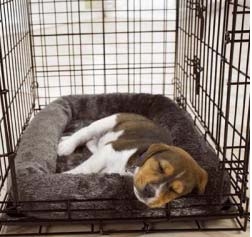Menu
Dog Crate Training
Dog Crate Training

| Container preparing is another idea for some, however it is an extremely powerful preparing apparatus for grown-up canines and puppies. It might require a little investment and push to prepare your canine to utilize the container, however it can demonstrate helpful in an assortment of circumstances. For example, in the event that you have another pooch or puppy, a case is a fabulous method for showing it the limits of the house and guarding it. When you're going in the auto, going to the vet or some other time you may need to limit your puppy (eg. after surgery or in the event that it has been harmed), it's considerably simpler and more secure if your pooch has been prepared to appreciate being in a wire dog crate. How big should my crate be and what type should I get? A compartment should be adequately gigantic for your pooch to stand up, rotate and rests. Cases can be plastic (used on transporters), wire (collapsible, metal pens) or collapsible surface containers. It isn't recommended to leave your canine for long extends in a surface box unless you are certain that your puppy will be merry and calm inside it and won't scratch out. I don’t like the look of a crate! What will my dog think? A box is expected to be a 'place of refuge' or 'familiar object' for the puppy. By nature, canines like little, encased spaces, particularly when they are feeling somewhat uncertain. By giving your pooch a territory where it can 'escape' and know it won't be annoyed, it can promptly search out this region when it needs somewhat of a break or time-out. Training your dog to use the crate The term of case preparing shifts from canine to pooch. It will rely upon the canine's age, disposition and past encounters. It is vital to recall that your carton ought to be connected just with something wonderful and preparing ought to dependably move at your pooch's pace. Continuously shift the period of time that your pooch will spend in its container, particularly amid preparing. This will keep your canine from 'expecting' to be let out at a specific time and decrease any issues, for example, crying or scratching at the carton entryway. Introduce your dog to the crate Present it calmly The most noticeably awful way you can acquaint your puppy with the possibility of a box is to bring it home and bolt him inside it quickly. Individuals don't care for being caught without wanting to, and neither do mutts. Rather, you ought to at first treat the carton like it's simply one more household item — yet one that he can appreciate. To this end, put it in a piece of the house that he frequents, include a cover and a toy or two, and keep the entryway open. At that point back off and allow him to investigate it. A few pooches will quickly begin sniffing around and going into the carton, which is an incredible sign. In the event that your puppy isn't exactly so intense, urge him to look at it by setting most loved nourishments and toys close and inside the box. A definitive objective is to get him OK with going inside, and this is something that could take days. Be quiet with the procedure. Make the case welcoming and agreeable for your pooch. At the point when your pooch goes close to the carton, remunerate it by tossing a nourishment treat into the container or close to its passageway. Rehash this each time the canine goes close to the carton. On the off chance that the canine settles down inside the carton, remunerate this conduct either with your voice or with sustenance rewards. You need the canine to see the container as a magnificent place to be, brimming with treats and fun. You would prefer not to close the entryway of the case presently. Your pooch needs to comprehend that it can travel every which way however it sees fit, fortifying it as a decent place to be. Feed your dog in the crate Start giving your pooch its general dinners in the container. Place the bowl inside the box and urge the puppy to enter. In the event that your canine promptly enters the carton at supper time, begin requesting that it go in and afterward put the sustenance inside the case. As the puppy turns out to be more happy with eating in the carton, you can present shutting the entryway. Begin by shutting the entryway as your puppy eats its supper. Ensure you open it before the pooch completes its feast. As you advance, step by step leave the entryway shut for a couple of minutes on end. Before long you ought to have a puppy that will joyfully remain in its case after a supper. On the off chance that the canine cries; overlook the conduct and attempt to compensate it or let it out when it is tranquil. Next time, ensure the pooch is in the box for a marginally longer timeframe. Increase the length of time spent in the crate Once your canine is glad in the box for around 10 – 15 minutes in the wake of completing its dinner, you can begin to keep it to the box for longer periods. Get the puppy into the container utilizing a charge, for example, "carton" or "bed". As the pooch enters the container, give it a treat, applaud it and close the entryway. Unobtrusively sit adjacent for a couple of minutes and reward the canine for keeping quiet and upbeat. You may even need to open the entryway and give the pooch a compensating regard apportioning toy, for example, a Kong. Proceed with your every day exercises and return frequently to remunerate the puppy, either verbally or with a sustenance treat, for its quiet conduct inside the case. Begin with short sessions and bit by bit increment the time span that you leave the puppy inside the container. This may take a few days or weeks. Crating your dog at night Once your canine is glad investing energy in its carton with you around, you can acquaint it with crating during the evening. Ensure your puppy has toys or treat-apportioning toys with it to at first settle it into the schedule. Keep the box in a commonplace, focal zone so the puppy feels good and settled. With youthful puppies or more seasoned mutts you may need to take them out for can breaks amid the night. By making the box a 'fun' and agreeable place to be, evening time crating ought to be a simple progress.. Potential problems Too much time in the crate Be cautious that your puppy doesn't invest excessively energy in its box. While it is an awesome apparatus for latrine preparing puppies and forestalling decimation, a puppy of all ages ought not spend throughout the day in a box while you are grinding away and again when you go to bed. This can influence your canine's muscle advancement and condition. Youthful puppies shouldn't spend more than 2-3 hours in the box without a latrine break as they can't keep going that long without diminishing themselves. Whimpering - - - On the off chance that your puppy starts whimpering in its case, the best activity is overlook it. For a youthful puppy, crying may happen on the grounds that it needs to alleviate itself, so discreetly take it out to the can on a lead, making a point not to play with it. Place it once more into its carton once it has gone to the latrine. Keep in mind that any kind of cooperation, positive or negative, will be a 'reward' to the puppy, so disregarding the whimpering is ideal. In any case, ensure that you remunerate the canine properly when it has settled and is peaceful. Utilizing a towel or sheet to cover the container if the whimpering perseveres can likewise help settle the canine. By following these means, you can prepare your pooch to love its carton, as well as consider it to be a place of refuge. Your canine's carton can be a place to escape for a genuinely necessary rest, a break from kids or different puppies, and even a compact home that will dependably be well-known regardless of where you are. The genuine purpose behind carton preparing! Other than counteracting issues, is to enable you to foresee when the pup should wipe out, so you can take him to the right spot. The initial step is to begin a customary encouraging timetable. Restrict him in the wake of eating for 10 to 15 minutes, and after that take him to the end spot. I say, "Go pee." They do comprehend, and will figure out how to pee on summon. Adulate him after he wipes out. At that point take him back in and play with him, or on the off chance that he prefers it outside, play with him outside, or take him for a stroll (after third arrangement of shots). On the off chance that he REALLY loves it outside, and you persistently take him inside subsequent to dispensing with, he will figure out how to HOLD it to broaden his outside time. In the event that you intend to take him for a walk, at that point he ought to do his wiping out at home, before you go. Numerous individuals take their pups for a walk, and when they dispose of, they bring the puppy home, consequently sending the message that they are going home in light of the fact that the canine dispensed with. On the off chance that you need to begin your head right in the opposite direction, don't pivot and head home when he craps. Following a half hour of play, carton him for a rest. Consistently (as he ages) take him out to pee. In the event that he pees, give him play time, if not, once more into case. Simply recall aversion of mix-ups, and remunerating for good conduct. a month and a half—end each hour 2 months—pup ought to have 2 to 3 hours of control 3 months—4 hours 4 months and up—5 hours Numerous youthful mutts can go throughout the night at 3 months. Continuously take the puppy out a similar entryway, the one you will need him to motion at. Ringers work extraordinary for a few proprietors. Hang chimes on the entryway, and give them a kick each time you open the entryway. A few mutts can be tranquil, and remain at the entryway and take a gander at it, some will let out a little howl, however others depend on you to see them remaining at the entryway. So ringers can be a sublime instrument. They will figure out how to swat them to get the way to open. Others utilize doggy entryways. Yet, a youthful pup can never be conveyed to pee, he should be taken out. |
